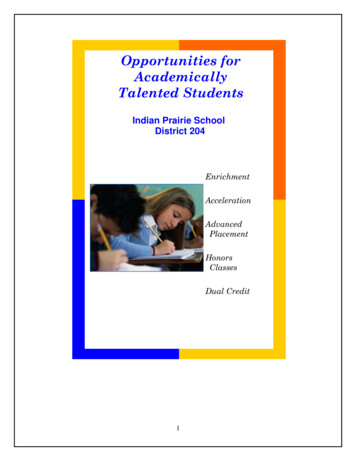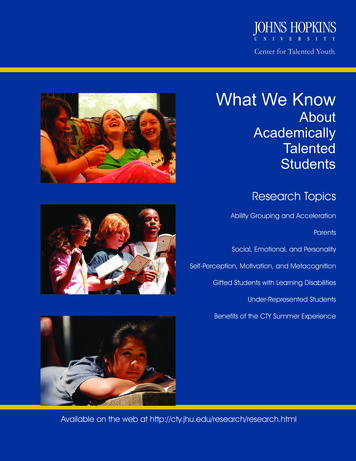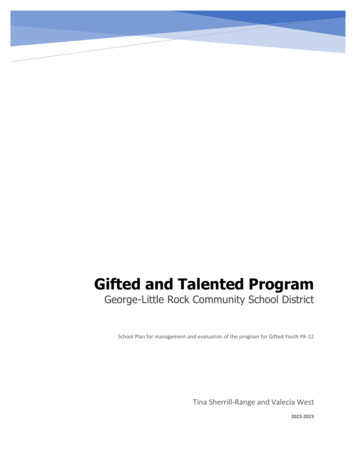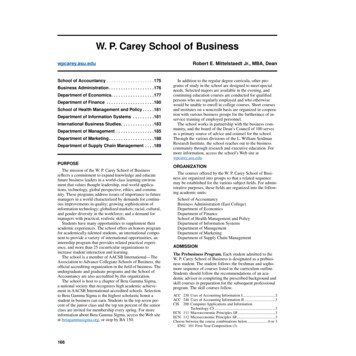
Transcription
Opportunities forAcademicallyTalented StudentsIndian Prairie SchoolDistrict assesDual Credit1
Gifted Education in Indian Prairie School DistrictThere are many definitions and interpretations of the term “gifted” used across states and schooldistricts. Our District utilizes the United States Office of Education’s 1993 definition: “Childrenand youth with outstanding talent perform or show the potential for performing at remarkablyhigh levels of accomplishment when compared with others of their age, experience, orenvironment. These children and youth exhibit high performance capacity in intellectual, creativeand/or artistic areas, possess an unusual leadership capacity, or excel in specific academic fields.They require services or activities not ordinarily provided by the schools. Outstanding talents arepresent in children and youth from all cultural groups, across all economic strata, and in all areasof human endeavor.”The National Association for Gifted Children estimates that approximately 6% of the US K-12student population can be identified as academically gifted. In District 204, the percentage ofstudents who qualify for gifted services will vary from school to school and also within gradelevels. Multiple identification criteria are used to identify students whose profile best fits with theprogram options currently in place.District 204 gifted services are designed to meet the specialized needs of gifted learners. TheProject Arrow program specifically addresses the academic needs of those in grades two througheight. These students may or may not show high performance on daily work, but exhibitadvanced thinking skills that either require an accelerated pace or more challenging processskills. The program allows interaction with peers of similar ability. It includes a variety of servicesranging from classroom enrichment at the elementary level to modified/accelerated curriculumfor higher age levels.2
Vision/Mission/GoalsVisionAt Indian Prairie School District 204, we believe that gifted program services will encouragestudents to:oValue and utilize their individual talentsoApply and value learning and knowledgeoCommunicate their ideas effectivelyWe believe academically talented students are entitled to programs and services supportive oftheir needs.MissionThe mission of the gifted program is to identify academically talented students and provide themwith a learning environment that offers an enriched/accelerated curriculum and promotesinteractions with academic peers.Program Goals1.2.3.4.5.6.Identify a diverse population of academically talented students;Promote excellence and rigor in the curriculum;Enrich/accelerate grade level curriculum;Provide consistent and challenging instruction to identified students;Create an environment that encourages risk taking and personal growth;Promote staff and community understanding of gifted students’ needs andservices; and7. Employ evaluative practices and procedures.3
Grade Level ServicesElementary SchoolDirect contact time with a Gifted Resource Teacher is provided through a pull-out program for aminimum of 200 minutes a week for grades 3-5, and 150 minutes a week for grade 2. Anidentified gifted student’s program will include modified, and often integrated, curriculum unitsthat focus on higher level thinking skills.Project Arrow students are grouped in clusters of 4-7 students in 2nd-5th grade classrooms. Eachelementary school has a Gifted Resource Teacher who collaborates with classroom teachers todifferentiate curriculum and instruction.Middle SchoolIdentified gifted students are scheduled for the appropriate Strands. Students may be placed inthe Project Arrow Reading Strand and/or Math Strand.The Reading Strand includes placement into Project Arrow literacy, science and socialstudies.The Math Strand includes pre-algebra in 6th, algebra in 7th and geometry in 8th grade.High SchoolHonors, Advanced-Placement and Dual Credit Courses are offered in many areas. Please refer tothe current high school course catalog for a complete listing of opportunities and requirementsfor enrollment eligibility.Level of Service Delivery SystemStudents Eligible(% varies by building)ServiceTop 1 - 5 % ileStudent-based serviceTop 6 - 10% ileCurriculum-based serviceAcademic advancementAccelerationCurricular enhancementTop 20 % ile4
Identification of Academically Talented LearnersThe identification process takes place at each individual school. Team members utilizemultiple criteria to ensure a student’s academic needs require services offered throughthe Project Arrow program. Listed below are procedures that occur at every school.Supplementary relevant data may also be used to identify students. Typically, placementof students occurs in the spring with PA classes scheduled for the upcoming school year.Students who are new to the district, and who have already been identified for giftedservices elsewhere, may join the program as soon as required documentation iscomplete. If additional testing is required, parents will be contacted by the school’sStudent Services Coordinator or Guidance Counselor.ElementaryGrade 1: A small group of recommended 1st grade students take the Cognitive Abilities Test andthe Iowa Assessments in January. Classroom teachers are asked to evaluate students in theareas of Learning Characteristics, Creativity and Motivation. Classroom and district assessmentsand demonstrated classroom performance are also taken into consideration. A student profile iscompleted which identifies students who achieve within the top levels of performance criteria asdesignated by the district. Standardized test scores of students placed in the program aretypically above the 95th percentile.Grades 2-5: All 2nd and 5th graders take the Cognitive Abilities Test in the fall. All 2nd – 5th gradestudents being considered for PA take the Iowa Assessments in January. Teachers are asked toevaluate students in the areas of Learning Characteristics, Creativity and Motivation. Classroomand district assessments and demonstrated classroom performance are also taken intoconsideration. A student profile is completed which identifies students who achieve within the toplevels of performance criteria as designated by the district. Standardized test scores of studentsplaced in the program are typically above the 95th percentile.Parents whose children participated in the optional testing receive a letter which includes testingresults and notification of placement decisions. Any questions regarding placement should bedirected to the school Student Services Coordinator. Parents, teachers or administrators mayrequest a review of placement decisions.Middle SchoolGrades 6-8: The middle school PA program is separated into two Strands —Reading andMathematics. A separate qualification is necessary for each. Identified students meet designateddistrict criteria. Parents are notified of student eligibility for either strand. Questions regardingplacement should be directed to the middle school’s grade level Guidance Counselor.Qualification process for the Middle School Project ArrowProgram for incoming 6th graders:Reading StrandStudents qualify for the Reading Strand using the results from the mostrecent administration of the Cognitive Abilities Test, the Gates-MacGinitieReading Tests and the Iowa Assessments, and information from teacherrating scales. The rating scales focus on Learning Characteristics,Motivation and Creativity. Classroom and district assessments anddemonstrated classroom performance are also taken into consideration.Mathematics StrandStudents qualify for the Mathematics Strand using the results from the spring administration ofthe Iowa Algebra Aptitude Test and the Differential Aptitude Tests.5
Qualification process for the Middle School Project Arrow Program for in-district 6thor 7th grade students:Reading StrandStudents qualify for the Reading Strand using the results from the most recent administration ofthe Cognitive Abilities Test, the Gates-MacGinitie Reading Tests and the Iowa Assessments, alongwith information from teacher rating scales. Classroom and district assessments anddemonstrated classroom performance are also taken into consideration.Mathematics StrandStudents are required to take the Scholastic Aptitude Test (SAT) which is offered on a Saturdaymorning in January or February. This test, usually administered to high school juniors, is utilizedin determining eligibility for placement into the PA math classes.All current PA and math acceleration students in grades 6, 7, & 8 are invited to take the test. 6 thgrade students who take the SAT and score 480 on the math section are eligible to take Algebrain 7th grade. 7th grade students who score 520 on the math section, and wish placement into PAMath as an 8th grader, must take a fast-paced Algebra class offered by the school district or localcommunity college in the summer in order to be prepared to take Geometry in the fall of thefollowing school year.CurriculumProject Arrow Curriculum Goals (Grades 2-8) To provide for the mastery of basic skills while affording students an opportunity toincrease pace, depth and level of learning To promote the development and application of criticalthinking and reasoning skills To encourage divergent thinking To encourage advanced oral and written skills To develop research skills and methods To address characteristics unique to the gifted populationElementary CurriculumGrades 2-5 (Project Arrow)The curriculum includes an enrichment-based emphasis in language arts,social studies, science, and mathematics. A variety of literature and informational text isincorporated into each year’s studies. Focus is on high level comprehension and vocabularydevelopment. Sample units at the elementary level include: Autobiographies, LiteraryReflections, Neurology, Archeology, Algebraic Thinking and Geometric Exploration.The Elementary Gifted Educational Framework emphasizes four Strands at all grade levels:Critical Thinking, Creative Thinking, Problem Solving, and Research. Affective andcommunication skills are addressed throughout each Strand at each grade level.6
Middle School CurriculumGrades 6-8 (Project Arrow)Students utilize higher-level thinking skills through a modified curriculum which includes bothinterdisciplinary units and content-specific academic units. Math, reading and language arts aretypically taught at an accelerated level, whereas science and social studies include more in-depthlearning units. An in-depth, annual research project, Science Fair, is an integral component of thePA science program for the majority of the students. The social studies program is also enrichedand differentiated for academically talented learners.High School CurriculumHonors, Advanced Placement and Dual Credit Courses are available – see current highschool course catalog for individual course descriptions and requirements for enrollment.Current Dual Credit options are available in conjunction with the University of Illinois,North Central College and the College of DuPage. Contact the high school guidancedepartment for information.Applied TechnologyAutomotive Servicing (Weighted-Grade): Net CertificationElectricity (Dual Credit), Architectural Drafting (Dual Credit)Business EducationAP Microeconomics, AP Macroeconomics, Desktop Publishing & Computer Graphics I(Dual Credit –when both are completed)EnglishHonors English I, Honors English IIAP English III, AP English IVFine ArtsAP Studio Drawing, AP Studio 2D; AP Studio 3D, AP Art HistoryForeign LanguageAP French, AP German, AP SpanishMathematicsHonors Geometry, Honors Algebra II/Trig., Honors Math AnalysisAP Statistics, AP Calculus AB, AP Calculus BC, AP Computer Science, Calculus III(University of Illinois Calculus 241 ( Dual Credit))MusicAP MusicScienceHonors Biology, Honors Chemistry, Honors PhysicsAP Biology, AP Chemistry, AP Physics, AP Environmental ScienceAnatomy and Physiology, Horticulture, Genetics (College of DuPage Dual Credit)Social StudiesHonors World History, AP Human Geography, AP Art History, AP World History, AP U.S.History, AP Psychology, AP European History, AP Government and Politics – US, APGovernment and Politics - Comparative7
Accelerated MathematicsThe accelerated math program was created on the recommendations of parents, teachers andadministrators who recognized that more and more students demonstrated the need foradvanced math instruction. Although math acceleration is often part of many other district’sprogramming services for the gifted, it is considered a separate program by District 204(requiring separate qualifications).The program is designed to begin at third grade and continue each year through high school.The program is for students who demonstrate a strong knowledge of math facts andmathematical problem solving and are beginning to apply that knowledge in different ways.Third grade students will learn skills typically presented in the third and fourth grade mathcurriculum. Fourth grade students will learn skills through the fifth grade curriculum and fifthgrade students will continue on through the sixth grade curriculum. Students placed in theprogram are expected to master skills at a quicker pace.Placement will be determined by scores obtained on math placement tests, local assessments,standardized tests and teacher recommendation. The middle school program has similar criteriafor entry and will accelerate students to allow them to complete a standard high school algebracourse by the end of eighth grade. Questions concerning this program should be addressed toyour child’s classroom teacher or the building principal.Project Arrow Math is offered at the middle school. This is more highly selective in its entryrequirements as it is a two-year accelerated sequence. In PA math, students complete a 2 yearhigh school math equivalence program by the end of the 8th grade (algebra in 7th grade andgeometry in 8th). Although PA students complete these high school classes, they DO NOTRECEIVE high school math credits towards high school graduation (by Illinois State Statute).Instead, they “move on” to higher mathematics immediately upon entering high school. A fewstudents completing the PA math strand while in the middle school may be required to enroll in asummer “math refresher class” in order to continue on in an honors mathematics sequence atthe high school rd EDM4th EDM44th EDM5th EDM55th EDM6th EDM66th course IIMath7th Course IIIMathPre-Algebra77th CourseIII MathPre-AlgebraAlgebra8Pre – AlgebraAlgebraGeometry9AlgebraGeometryHonors Algebra II/Trig10GeometryAlgebraII/TrigHonors Math Analysis11AlgebraII/TrigMathAnalysisCalculus AB, BC12MathAnalysisCalculusStatistics, Computer Science,Calculus III8Project ArrowProgram
Glossary of TermsAcceleration refers to the strategy of teaching content at a faster pace and usually a yearahead of the designated instructional grade level placement. Presently in the District, weaccelerate math instruction beginning at third grade and begin formal math & reading contentarea acceleration at the sixth grade level with Project Arrow.Cluster grouping occurs when a group of four to seven identified gifted students are“clustered” in the classroom of a teacher who has been trained in differentiation. This strategyallows students to work with academic peers throughout the school day.Creative thinking is divergent. It involves exploring ideas, generating possibilities, and seekingmore than one right answer. Terms used with students in discussing this type of thinking includebrainstorming, fluency, flexibility, originality and elaboration.Critical thinking is deliberate and utilized in all academic areas. Critical thinking includesanalyzing, evaluating, inferring, interpreting, judging, problem solving and synthesizing.Curricular enhancement is a compilation of methods, materials and activities which teachersmay use as a basis to modify curriculum for students having already demonstrated mastery in aparticular area.Curriculum-based services are modifications made to course content and instructionalstrategies used by classroom and gifted resource teachers. The modifications often result inchanges in the accomplishments or requirements of the individual students.Curriculum Compacting involves streamlining, condensing or eliminating grade levelcurriculum for students who have already achieved goals and objectives of the regularcurriculum.Differentiation is the process of adapting the curriculum according to the ability or interestlevel of the student. It is specifically geared to content, process or product.Enrichment often involves extensions of the grade level curriculum. Classroom teachers mayask specific questions which have the student thinking on a higher level or provide activitieswhich allow the student to investigate further into an area of study.Student-based services are modifications to the student’s program of learning which arebased upon the student’s ability. Services are available at the elementary level through gradeskipping or math acceleration.This document is designed to provide a brief overview of program services for academically talentedstudents. The Project Arrow Teacher, Student Services Coordinator or Guidance Counselor at your child’sschool is able to answer specific questions you may have pertaining to the program and services.9
Middle School Identified gifted students are scheduled for the appropriate Strands. Students may be placed in the Project Arrow Reading Strand and/or Math Strand. The Reading Strand includes placement into Project Arrow literacy, science and social studies. The Math Strand includes pre-algebra in 6th, algebra in 7th and geometry in 8th grade.










